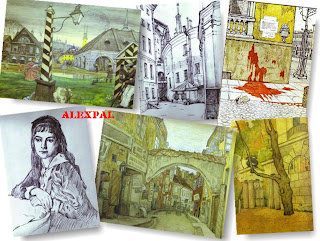 Art by Mstislav Dobuzhinsky
Art by Mstislav Dobuzhinsky
28 JPG - 800x600 - 1 Mb
Mstislav Valerianovich Dobuzhinsky
or Dobujinsky Lithuanian: Mstislavas Dobužinskis (2 August 1875, Novgorod — 20 November 1957,
New York City) was a Russian-Lithuanian artist noted for cityscapes conveying the explosive growth and decay of the early twentieth-century city.
Of noble Lithuanian extraction, Dobuzhinsky finished Second Men's Gymnasium in Vilnius, later was educated in St Petersburg, Nagybanya and Munich, where he came to be influenced by the Jugendstil. Having returned to Russia, he joined the Mir iskusstva, an artistic circle which idealized the late 19th and early 20th centuries as a golden age of Russian cultural achievement.
Dobuzhinsky was distinguished from other miriskusniki by his expressionist manner and keen interest in modern industrial cityscape. He often painted seedy or tragic scenes from urban life which expressed the nightmarish bleakness and loneliness of modern times. Among his works were also humorous vignettes and sketches with demon-like creatures which seemed to embody the monstrosities of urbanization.
Like other members of the Mir iskusstva, Dobuzhinsky experimented with scenic design. At first he worked for Constantin Stanislavski at the Moscow Arts Theatre, but later contributed sets to several Diaghilev productions as well. He also gained renown as an excellent art teacher; among his young pupils was Vladimir Nabokov, with whom he maintained correspondence for decades.
After the Russian Revolution of 1917, Dobuzhinsky followed the advice of Jurgis Baltrusaitis and withdrew to Lithuania. He was naturalized there in 1924 and lived in Kaunas until 1925, and later 1929-1939, when he emigrated to England and later to USA. In Lithuania he was working in State Theatre as scenographer and created scenography for 38 plays, held his private painting school (1930-1933).
1925-1929 he worked in Paris, Brussels, Amsterdam, and Duseldorf theatres.